
Review
Wreckreation is more of a sandbox than a racer
by Kim Muntinga

Magic, monsters and resource management: "Darfall" combines building strategy with tower defence and RPG elements. The genre mix works - as long as you accept compromises in terms of technology and depth.
The fog lies heavy over the gloomy pine forest as I erect my first buildings. A woodcutter's hut, a mine and a few houses for settlers who have no idea what awaits them at night. The day in the survival mode of «Darfall» seems peaceful, almost cosy - but that is an illusion. The real game begins at night. And it comes quickly.
«Darfall», developed by SquareNite, is a real-time building strategy game with tower defence elements and magic - garnished with light action RPG ingredients. It combines base building, resource management and fighting against waves of monsters at night. The whole thing is embedded in a dark fantasy world in which it can quickly become claustrophobic when the horizon is swallowed up by darkness.
The game offers two central modes: the campaign and the survival mode. The campaign is a loosely connected series of missions on a large world map in which I gradually open up new areas, upgrade my hero and unlock new technologies. It allows me to slowly grow into the game mechanics and understand the different systems bit by bit. Each map brings new challenges and small variations in the structure. The day-night mechanics don't play a role here.
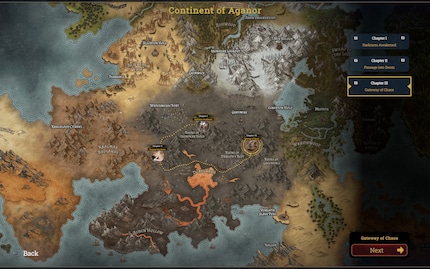
Survival mode, on the other hand, throws me straight into the fire: limited resources, immediate threat, free building - and the constant pressure to think about the next attack. It's less about exploring the map, although this can also help, and more about surviving.
While the campaign is more structured and beginner-friendly, the survival mode appeals to all those who like quick, tough decisions and like to be moulded by the brutality of the night. Not only the waves of monsters, but also the faint vision of darkness are added here.
I started the campaign myself to familiarise myself with the world and its mechanics. And although «Darfall» didn't take me by surprise, I felt it right from the start: This world is merciless if I underestimate it.
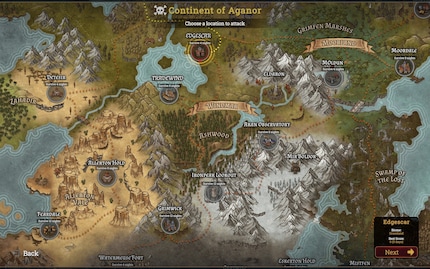
My first confrontation in «Darfall» is surprisingly low-key. No base, no workers, no resources. Instead, I am thrown directly into the dark fantasy world of Aganor as a hero character. The first campaign mission serves as a gentle introduction. I learn how the combat system works and how to use my hero's special abilities.
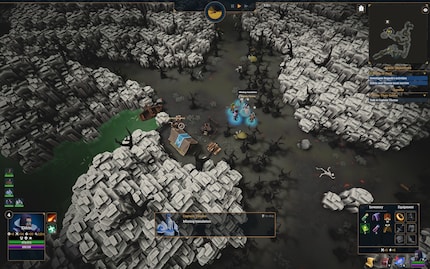
It's only in the second mission that the construction aspect is added. I can finally collect resources, erect buildings and place defences. My workers chop wood, mine ore and grow food. At the same time, I explore the map with my hero, loot crates, take out smaller enemies or help collect resources. This is particularly useful when certain materials become scarce. I also had to survive attacks from enemies at regular intervals.
The gameplay thrives on decisions under pressure: Do I build a farm first or a defence tower? Do I invest the wood I collect in new buildings or use it to build planks? Do I use these planks for higher-value buildings or make bows for fighters? All these decisions feel important, even if the game could do with some fine-tuning in places. Convenience functions such as building priorities or intelligent pathfinding are currently missing. Especially in hectic situations, I realise how valuable such tools would be.
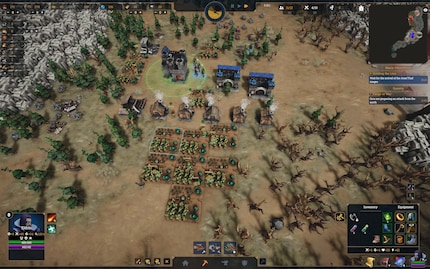
Nevertheless, the interplay between base building, real-time battles and the hero system works. It is not a reinvention of the genre and would need a better balance in some places. However, it is a harmonious mix that motivates with its constant threat and clear cycle of calm and danger in survival mode.
What I particularly like about «Darfall» is the constant feeling of never really being safe. Even in the quiet moments - when my workers are doing their rounds, the sun is shining through the treetops and everything seems stable for a few minutes - there is something in the air. A restlessness. As if the world already knew that I would soon have to fight again.
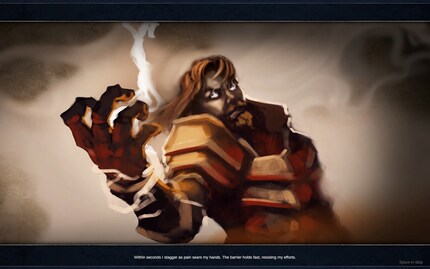
Visually, «Darfall» relies on a clear, symbolic style. Forests, rivers, fog and ruins tell little stories without a single spoken dialogue. In the campaign, I wander through ruined villages, barren plains and swamps steeped in magic.
In survival mode, everything seems even more urgent. As the day draws to a close, the fog stretches its fingers across the landscape, shadows eat into paths and woodland. My camp, just a place of hope, turns into a fortress of fear. The towers flicker in the magical light, my units form up and I can only hope that I will survive the next wave of enemies. My opponents use the darkness of the night to protect themselves. I can barely make them out. So they secretly damage or destroy important buildings.
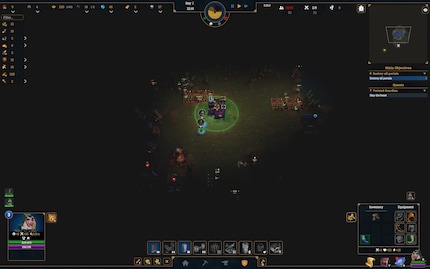
«Darfall» is not a total technical failure - but it is also far from polished. In my first few hours of playing, it was mostly stable, but the larger my settlements became, the more often I felt performance drops. And I never had more than 20 workers and fighters combined. This is nothing dramatic in this early version, but it is noticeable. I would like to see quick fixes here in the full version.
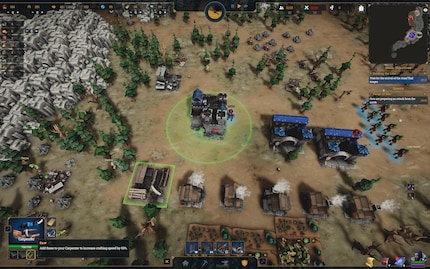
The user interface is functional, but anything but elegant. Resources and units are generally clearly recognisable, but a lot of information - such as buffs or efficiency values - is either hidden or not available at all. Especially in the hectic survival mode, I would have liked finer controls, such as priorities for workers or clear resource management.
On the one hand, I think the further development of my hero is quite successful. This is clearly presented and fun. On the other hand, equipping and changing the inventory works very well. The only thing I found a little irritating at first was comparing values, until I understood what the game wanted from me.
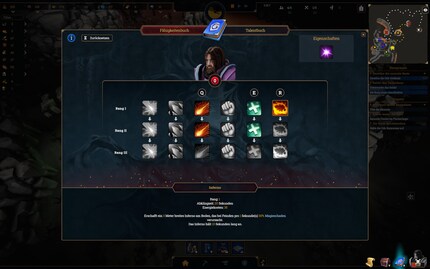
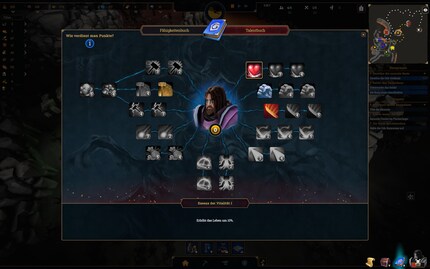
«Darfall» doesn't want to be a cosy strategy game - I quickly realise that. Even though the campaign starts gently, the demands increase significantly afterwards. Each map confronts me with new restrictions or challenges: for example, too few resources, unfavourable starting positions or nasty little missions in between. I had to learn to build efficiently, time resources well and always have a contingency plan.
The difficulty level becomes more challenging as the game progresses, but not unfair. If I fail, I know exactly what it was - built too late, prioritised incorrectly or not enough defence. However, some things didn't feel quite balanced. I particularly noticed this in resource management. The dependence on wood is extreme. The behaviour of the AI also fluctuates: sometimes it attacks weak points in a targeted manner, other times it runs headlong into walls or into my army.
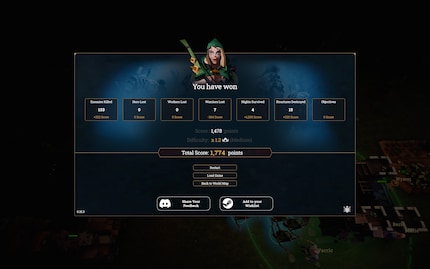
«Darfall» was provided to me by SquareNite. The game is available for PC as of today, 8 May.
"Darfall" is not a masterpiece - but it is a game with character. It brings a familiar but effective mix of building strategy, survival, tower defence and a touch of action RPG to the screen. I particularly remember the atmosphere.
The mechanics are solid, the gameplay works - even if it still feels a little rough in places. The controls, the interface and the balancing still need some fine-tuning in many areas. Nevertheless, I had the feeling that I could create, defend and improve something in this world. The hero character as a playable person brings variety, but does not become the centrepiece of the game.
The two modes - Campaign and Survival - appeal to different types of players and complement each other well. The campaign allows you to grow into the game slowly, while the survival mode immediately demands everything. A clear game rhythm of building, preparing and tactics unfolds, which develops its own unique pull. Even without an epic story or constantly new systems, the game can be motivating - especially through the daily struggle for survival.
However, there is still a lack of depth in terms of content. The maps and enemy types offer too little variety to keep you hooked in the long term. Additional objectives, random events or modifiers would have the potential to make each run feel fresher and significantly increase the strategic variety. Despite these weaknesses, the classic basic concept carries the game - especially for fans of build-up and survival strategy.
Pro
Contra
My interests are varied, I just like to enjoy life. Always on the lookout for news about darts, gaming, films and series.
Which films, shows, books, games or board games are genuinely great? Recommendations from our personal experience.
Show all